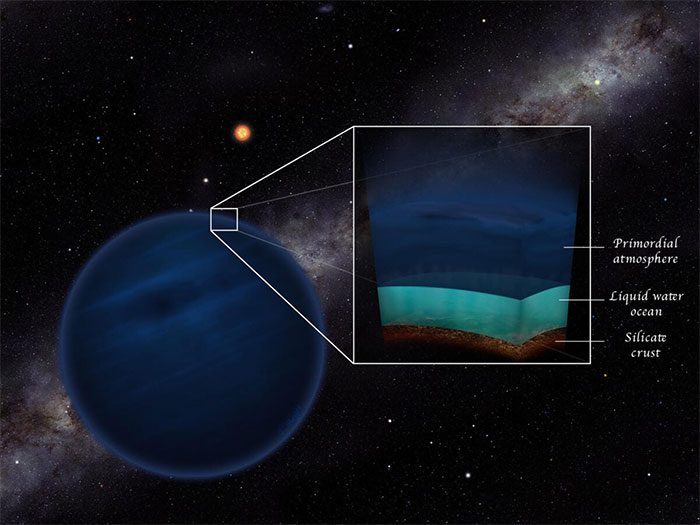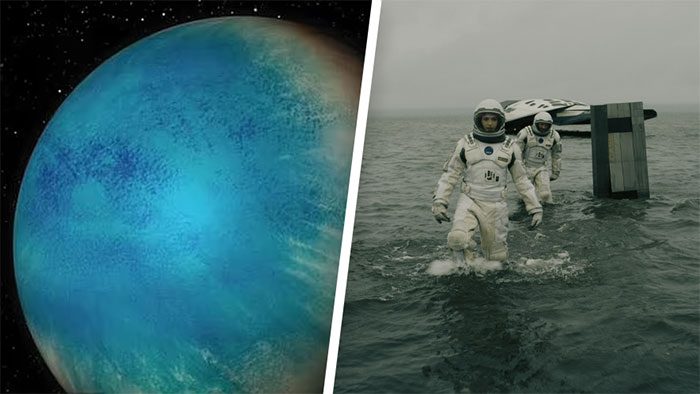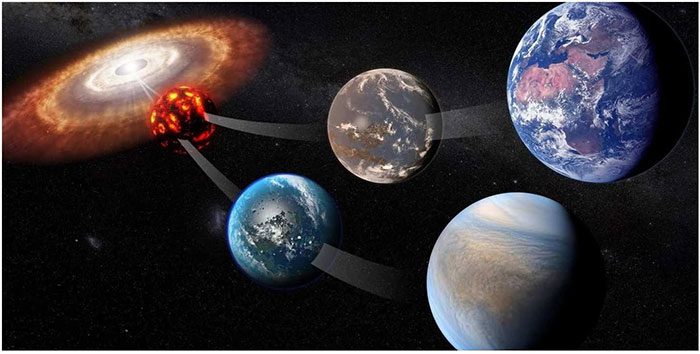Deep in the distant universe, scientists have recently been astonished to discover an incredible phenomenon – a planet located 100 light-years away from Earth, and the entire planet is covered by a vast ocean!
Water-Filled Super-Earth Located 100 Light-Years Away
This super-Earth lies within the habitable zone of its star, which means that the temperatures near it are suitable for the existence of life and there is enough liquid water, light, and heat to provide viable conditions for the formation and sustenance of life. Scientists using advanced telescopes have observed signals from the super-Earth indicating clear signs of the presence of water and oxygen on this planet.

Super-Earths have rocky compositions similar to Earth, meaning they may also contain liquid water. Water is a fundamental element essential for the existence of living organisms, so if suitable conditions exist on a super-Earth, the emergence of life is not a distant dream. This has sparked significant interest among scientists regarding super-Earths. (Image: Zhihu).
This discovery is exciting because life on Earth depends on the existence of water. Water is the foundation of life, providing nutrients, regulating body temperature, and serving as the necessary medium for chemical reactions. If liquid water exists on this super-Earth, we have greater hope of finding life forms in other universes.
Now, scientists are working hard to interpret the information from the super-Earth and are planning to launch a series of future detection missions to learn more about this mysterious planet. They hope to confirm through further research whether any forms of life exist.
This discovery has also raised further research interests regarding the formation and evolution of planets. Scientists believe the amount of water on the super-Earth is immense and could surpass the amount of water on Earth. Therefore, humans are beginning to contemplate the possibility of interplanetary water reuse and the potential for long-term human habitation in space in the future.

The atmosphere of the super-Earth may also resemble that of Earth. It is Earth’s atmosphere that protects us from cosmic rays and solar winds. A stable and life-friendly atmospheric environment plays a crucial role in the existence and development of living organisms. If the atmosphere of super-Earths provides adequate protection and suitable climatic conditions, they could become locations for the emergence and reproduction of life. (Image: Zhihu)
New Discoveries Reveal the Amazing Diversity of the Universe
One of the most notable discoveries made by scientists is the Eddheim Lake on Charon, a moon of Saturn. This lake contains a liquid methane ocean. This opens up new possibilities for our understanding of the origins and evolution of life. On Earth, water is the foundation of life, and in Eddheim Lake, liquid methane has become a viable environment for life. Future missions may conduct deeper studies on this mysterious lake, helping us understand the existence of life on other planets.

The gravitational force of the super-Earth poses a potential challenge for us. The moderate gravity of Earth allows us to stand upright without being crushed by its gravitational pull. However, if the gravity of the super-Earth exceeds 2 to 3 times that of Earth, humans may require a long time to adapt. Nevertheless, scientists have studied organisms under higher gravity conditions in experimental facilities like space stations and have demonstrated that they can adapt and reproduce, which gives some hope for the exploration of super-Earths. (Image: Zhihu)
Moreover, Mars, Earth’s closest neighbor, may also hide secrets about water worlds. Recent studies have revealed the presence of a large amount of frozen water beneath Aeilian Planitia in the southern polar region of Mars. This discovery has drawn significant interest from the international space community as it means we could potentially harness frozen water to provide fuel and water for future astronauts. At the same time, the frozen water on Mars increases the chances of discovering microbial life on the planet.
Scientists have long been intrigued by the oceans on Europa, the only place in the Solar System where liquid water geysers have been found. By shooting jets of water at extremely high speeds, scientists can further investigate the potential existence of life beneath this ocean. So far, the discovery of water columns at Europa has gathered some evidence for the existence of underwater life, but further research and exploration are still needed.

Scientists have made significant progress in exploring super-Earths. For example, they have identified several potential super-Earth targets using various telescopes and other high-tech detectors. As technology advances, we expect to study these targets in greater depth in the future and explore their atmospheres and other geological features to provide more information about whether they are suitable for human habitation. (Image: Zhihu).
In this series of discoveries of water worlds, scientists have witnessed the spectacular diversity of the universe. This not only signifies that life may exist in ways we have never imagined but also helps us understand more about how life on Earth is connected to the rest of the universe. In the quest to explore the mysteries of the universe, the discovery of a water world gives us a glimpse into it, raising profound interest in the possible existence of life in other corners of the universe.
We must recognize that these discoveries only reveal the tip of the iceberg. At this stage, our understanding of the water worlds that may exist on other planets and moons is still limited; we need to invest more resources and research in this field to better understand the diversity in the universe and the forms of life that may exist. Such efforts will bring us closer to unraveling the mysteries of the universe.


















































